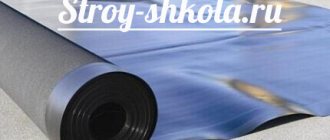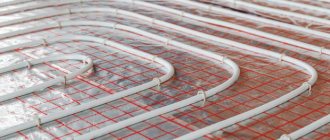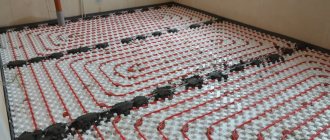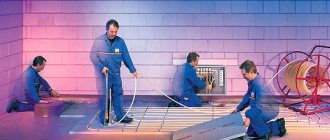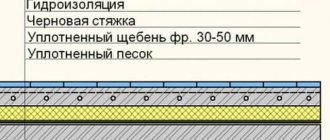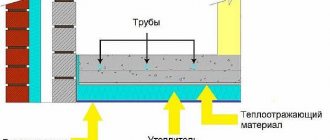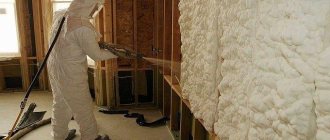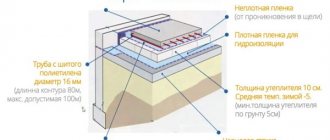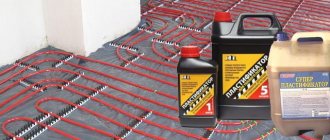Foil for underfloor heating - is it necessary?
A substrate with foil when installing a “warm floor” system is today one of the integral parts of the heating pie. Insulation with a foil layer most effectively saves the heat generated by the heating device and distributes it evenly.
This helps save heat resources, increases the potential of the heating system and the rate of heating the room, which in turn affects the life of the floor.
For your information! It is believed that using foil material in an electric warm cake is not safe, but this is misleading. Today there are many protective and insulating materials available.
The structure of the foil substrate includes a base and a foil. The base can be: basalt, mineral, polystyrene foam, polyethylene. Most of these thermal insulation products have a bubble structure. The surface of the foil for heated floors can be aluminum or metallized.
Advantages and disadvantages
As mentioned above, a substrate with a foil surface is an excellent material for saving energy. In addition, foil has a number of other advantages, but there are also disadvantages.
| pros | Minuses |
| Does not affect the height of the floor, since the foil material is only 2-10 mm thick. | High cost is the main disadvantage. |
| It is not difficult to install, so even an inexperienced person can handle the job. | It is not recommended to use a mineral substrate with a metallized layer for heated floors, since toxic substances are released during the heating process. |
| It has soundproofing and waterproofing properties. | Using such a substrate in rooms with high humidity significantly reduces its service life. A foil-coated product is recommended. |
| Withstands heating up to +90 degrees and more. | Dissolves upon direct contact with cement. |
| Most products with foil are equipped with markings, which simplifies the process of laying heating elements. | |
| There are models with a sticky layer, this makes installation easier. | |
| Reduces heat loss and promotes its uniform distribution. |
It should be noted that the foil product is strong and durable if installed and used correctly.
Types of substrates with foil
Currently, a large number of models of insulation with foil are sold; they have different bases and are intended for different construction work.
Watch the video - how different types of substrates work, reflection of thermal radiation, etc.
Penofol, Penofol, foil vs film (metalized)
Folgoizol
Underfloor heating made of foil insulation is most often used for the construction of baths and saunas. After all, the main advantage of folgoizolon is that it is not afraid of water and sudden temperature changes. The service life is long, since the product is not subject to rotting.
The material is environmentally friendly, has enhanced sound insulation properties, and is able to withstand mechanical loads. But due to its high cost, it is practically not used as insulation for residential premises, with the exception of luxury housing.
Basalt insulation
Basalt wool is the leader among insulation materials. It has low thermal conductivity and tolerates temperature changes well, in the range from -200 to +700 degrees. This type is equipped with a reflective surface, does not burn, and the installation process is simple.
Despite the fact that the insulation is not susceptible to heat, it is not recommended to use it in underfloor heating, since heating may release harmful substances.
Minvata
Mineral wool with a layer of foil has excellent thermal insulation properties, in addition, it is fireproof. However, the composition contains components that, when heated, release harmful substances, therefore it is contraindicated for warm systems.
It is also not suitable for places with high humidity, since cotton wool loses its properties when saturated with water. It is recommended for industrial premises.
Polyethylene foam
Polyethylene fabric with a foam structure and a reflective surface is considered the most popular type of insulation. Polyethylene with foil is suitable for both water-heated floors and cable floors.
Foamed polyethylene has good ductility and increased strength. The material is resistant to moisture, is not affected by chemicals, absorbs noise well, and does not contribute to the development of microorganisms. The service life of this type is long.
On the front side, the product is made of foamed polyethylene and has a Mylar film with a metallized coating. The reflective surface ensures uniform heat distribution, and the foam base with air cells does not allow warm currents to flow into the concrete screed.
For your information! Foamed polyethylene is afraid of ultraviolet radiation, but the finishing coating protects it from the penetration of sunlight.
Expanded polystyrene with foil
Expanded polystyrene covered with foil is a popular thermal insulator for heated floors: water and electric. It is inert to chemical attack and quite durable.
In addition, it can withstand temperatures from -180 to +180 degrees, although such temperatures are not required in everyday life. The product does not rot, does not contribute to the development of harmful microorganisms, and, therefore, does not harm human health.
Multifoil
Multifoil is a canvas made of many layers. A foiled aluminum layer with chambers filled with air, and the base of the product is polyethylene or propylene film. The bubble layer allows you to reduce heat loss to a minimum.
The insulation of this model is not susceptible to moisture, has a high thermal insulation potential, and increases the efficiency of the heating system.
Reflective insulation for the "warm floor" system Penoterm
Where can I buy?
Roll material made of foamed polypropylene, laminated with metallized Mylar film.
It combines the properties of two products: a reflective substrate for a “warm floor” system and vibration and noise insulation in a “floating floor” system.
Manufactured in accordance with TU 22.21.41-003-82799613-2017, GOST R 56729-2015
Application area
- suitable for electric, infrared and water floors;
- sound insulation;
- reflective insulation for all underfloor heating systems.
Main characteristics
- material 2 in 1: sound insulation + thermal insulation;
- reduces heating time;
- reduces heat loss, retaining heat;
- does not generate dust or crumble during installation;
- does not emit toxic substances during operation;
- does not absorb moisture;
- does not corrode or rot.
Advantages
The material is not subject to rotting and corrosion
Reduces energy costs
Environmentally friendly product
Ensures uniform heat distribution over the floor surface
Specifications
| No. | Parameter | Meaning | |
| 1 | Foam base color | grey | |
| 2 | Surface thermal reflection coefficient, % | 80 | |
| 3 | Water absorption in 24 hours,% | 0,74 | |
| 4 | Thermal conductivity coefficient, W/m°C | 0,034 | |
| 5 | Fire characteristics | G4 | |
| 6 | Operating temperature range, °C* | -40 to +150 | |
| 7 | Vapor permeability coefficient, mg/m2 h Pa | 0,001 | |
| 8 | Linear temperature shrinkage over 2 days, % | t = 100°С | 1,06 |
| t = 140°С | 3 | ||
| 9 | Impact noise insulation index, dB | 29 | |
* installation of the material is carried out at a temperature not lower than -25°C
Standard sizes
| Thickness, mm | Width, m | Length, m | Area, m2 |
| 2 | 1,2 | 25 | 30 |
| 3 | 1,2 | 25 | 30 |
| 4 | 1,2 | 25 | 30 |
| 5 | 1,2 | 25 | 30 |
| 8 | 1,2 | 15 | 18 |
| 10 | 1,2 | 15 | 18 |
Installation
- The Penoterm material is laid on the surface of the floor slab with the Mylar coating facing up. The seams are taped with metallized tape.
- Before pouring the screed, Penoterm damping tape is laid to prevent sound bridges.
- Heating elements are mounted on the reflective surface using special markings in strict accordance with the design. In this case, the contacts should be carefully insulated to avoid short circuits.
- The entire surface is filled with a monolithic cement-sand screed 40-80 mm thick. Additional protection for the reflective surface is not required, since it is made of a five-layer metallized polymer film and is capable of maintaining its properties in the alkaline environment of cement-sand mortar.
Certificates
Fire certificate for Penoterm sheet brands NPP LE (E), NPP LE (K), NPP LE E Aqua Protect, NPP LE K Aqua Protect, NPP LF, NPP LP (Penotherm LLC)
Certificate of conformity for sheet Penoterm brands NPP LE (E), NPP LE (K), NPP LE E Aqua Protect, NPP LE K Aqua Protect, NPP LP, NPP LF (Penotherm LLC)
Certificate of conformity SS TU and GOST for sheet Penoterm brands NPP LE (E), NPP LE (K), NPP LE E Aqua Protect, NPP LE K Aqua Protect, NPP LP, NPP LF (Penotherm LLC)
Certificate of conformity SS TU and GOST for sheet Penoterm brands NPP LE (E), NPP LE (K), NPP LE E Aqua Protect, NPP LE K Aqua Protect, NPP LP, NPP LF (Penotherm Company LLC)
What type of thermal insulation is better to choose and why?
When choosing foil material for heated floors, you need to consider:
- heat reflecting properties;
- thermal conductivity coefficient;
- resistance to high temperatures;
- presence of sound insulation;
- environmental safety;
- reaction to moisture;
- prostate in styling;
- fire safety indicators.
Video - ways to reflect thermal energy, how insulation works
Attention!!//The truth about foil insulation//where does such insulation work?//Ivan Serba 2021.
The price of insulation for heated floors also plays an important role. For example, polyethylene foam coated with aluminum, or polystyrene foam substrate with a reflective layer, are affordable in cost.
But when buying multifoil or foilisolone, you will need to spend a decent amount. Mineral or basalt type insulation, although inexpensive, is not suitable for warm floors.
In addition, the thickness of the foil layer also plays a big role. In cases where conventional spraying is used on top of the heat-insulating fabric as a reflective layer, the efficiency of the product is significantly reduced. The lower the quality of the reflective surface, the easier it is for heat to pass through it.
For your information! Products that are intended for insulation of walls or ceilings should not be used for heating floors. After all, there they will be subject to mechanical stress, which can lead to the loss of their properties. Therefore, you only need to install insulation intended for the floor.
Also, when choosing a thermal insulation material, it is important to consider that:
- More often, the product in tiles is used for heated floors;
- foil mats are used to make floating screeds; they are laid between the joists.
Thermal reflective underlay for heated floors
Encyclopedia mapWhen installing heated floors under linoleum, carpet, or laminate, a heat-reflecting substrate is used. The same applies to infrared heating film. The main function of the substrate is to reduce heat loss. It reflects the heat that comes down from the floor and is wasted, and also insulates the possible entry of cold from below. The use of insulation can reduce heat loss by 30%.
A high-quality heat-reflecting substrate for a heated floor can also perform the function of waterproofing - preventing the accumulation of condensation and the penetration of steam into the system. In addition, the substrate can level the surface, which is important when installing film floors, and reduce noise from neighbors living below. The heat-reflecting substrate should be laid so that its reflective surface is directed upward.
When choosing a substrate, it is worth considering that it should not contain aluminum, since it conducts electricity well. If the contacts are defective, this may cause a short circuit. Therefore, the use of foil as a heat-reflecting material is prohibited. For thermal insulation of a film floor, as a rule, a substrate made of foamed polymers, polypropylene, or laminated materials coated with a lavsan metallized film are used. Lavsan or polypropylene metallized film has a low thermal conductivity coefficient, good elasticity and does not absorb moisture.
For additional sound insulation, fiberboard is used as a substrate. With its help you can level the subfloor. As an alternative material for sound insulation, you can use 2 mm thick rolled cork. Rolled technical cork is made from cork oak. Dimensions 15000x1000 and thickness 4 mm are used as a substrate for heated floors.
When choosing a substrate for a heated floor, you should decide what kind of finishing coating is planned and how even the floor is. If you plan to lay laminate flooring, it is better to choose a soft underlay (types of penotherm), as it levels the floor. It is recommended to choose solid thermal insulation under linoleum. Linoleum is a soft material and, together with a soft backing, will be easily pressed under heavy furniture.
A soft substrate is also suitable for large differences in floor level, as it is more flexible. For small irregularities, it is better to choose more rigid types of thermal insulation.
Poliform is a universal insulation material, which is a chemically cross-linked polyethylene foam with a closed cell structure. Thanks to this structure, it has good heat-insulating properties (thermal conductivity coefficient - 0.037 V/m3 at 10 degrees C and density 30 kg/m3). The material is durable (service life more than 50 years) and effective for sound insulation.
Laying foil under heated floors
Installation work for installing a substrate on a floor with a heating system includes several stages.
Laying the heating cable on foil.
Preparatory activities
When starting to install a backing with foil under a warm floor, you should prepare the tools that will be needed for the work. Need to stock up:
- knife or scissors;
- tape measure;
- aluminum tape.
In addition, you should buy the required amount of the selected type of foil insulation.
Installation on cement screed
Laying the substrate under the heating device is as follows:
- The base is cleaned of dust and debris. If there are uneven spots and cracks on the slab, they are covered with a special solution, which must be dry before installing the backing.
- The reflector is prepared - it is cut to the required length.
- The material is laid from the corner of the room close to the wall, with the reflective surface facing up. Glue is applied pointwise to the base of the mats.
- The following strips are laid out end to end.
- The seams are processed using aluminum tape; this will prevent the formation of cracks, which will ensure high-quality heat and moisture insulation.
Afterwards, you can proceed to laying the heating system and flooring (linoleum, parquet, laminate).
For your information! When installing a cable or water system, you can use any type of insulation: with or without foil, and for infrared - only one with a foil coating.
In addition, when pouring a concrete screed onto a cable or water-heated floor, the quality of the aluminum foil substrate is significantly reduced. After all, when concrete comes into contact with foil, it corrodes it, thereby losing its properties.
Laying on wood
If the base is made of wood, then it is better to take insulation on a self-adhesive film. If you have a regular backing, you can use double-sided tape for fixation.
The working process is as follows:
- The base is prepared: dust and debris are removed. You can sand the surface with a grinding machine.
- To preserve the wood better, it is treated with an antiseptic.
- When the primer has dried, the insulation is rolled out, it usually comes in a roll, and the required size is cut off. The material is laid with the reflective surface up, the protective film is removed, and the insulation is pressed to the floor. The strips are laid at the joint, there should be no gaps.
- The joints are sealed with foil tape.
- The heating elements and flooring material are being installed.
The underlay is a mandatory layer of a heated floor, especially when building a private house or in apartments on the ground floor. And if you use insulation with a foil layer, the system will function much more efficiently.
Floor insulation
One of the most critical stages of installation is the installation of a heat-insulating layer on the floor or ground side if the floor is installed on the first or basement floor. Most heating elements radiate heat evenly in all directions. That is, heating is carried out both in the part of the floor above the heater and below it. There is no need to heat everything below - this is an unproductive loss of energy. The heat goes into the ground, parts of the building structure, walls...
According to engineers, up to 20–25% of energy is lost. This inevitably affects the amount of payments for electricity or gas. Losses are approximately equal for all types of floors, both electric and water. Therefore, when talking about heat losses and ways to reduce them, we mean systems of all types and types. They work according to the same physical laws and the methods for minimizing losses are also the same.
The simplest and most effective way is to install a heat-insulating layer under the heater. There is one feature here - the entire underfloor heating system should not exceed 5 - 7 cm in height. Considering the size of the heater, the thickness of the screed and the floor covering, there is little space left for thermal insulation. But there must be one. You should choose only the best materials, distinguished by:
- strength;
- low thermal conductivity;
- durability;
- resistance to dampness;
- temperature resistance.
Materials for thermal insulation
When choosing a material for thermal insulation, it is necessary to take into account the specific location of the apartment. If it is located on the second floor or higher, then the thermal insulation layer may be thinner - the heat coming from below from the heated room partially compensates for the losses. For ground and first floors, basements and garages, it is best to choose powerful thermal insulation. Its thickness is adjusted by deepening the base (if there is no concrete slab there). You can also sacrifice 1 - 2 cm of room height.
A variety of materials are used for thermal insulation. This:
- penofol;
- extruded polystyrene foam;
- cork;
- URSA insulation;
- mineral wool;
- glass wool...
All materials have their own advantages and disadvantages; it is important to choose one so that in a particular case the disadvantages are offset by the design features of the floor, and the advantages are fully manifested. But, regardless of the budget allocated for the arrangement of the floor topology, thermal insulation is mandatory. Her role:
- protection against heat loss through the base;
- ensuring uniform heating of all areas of the floor;
- additional sound insulation;
- eliminating the threat of cold and damp penetration from below.
Let's look at the main materials for floor insulation in more detail.
Penofol
First on the list is penofol. This is polyethylene foam glued with aluminum foil. The foil can be on one side or on both. In the first case, penofol is installed with the shiny layer facing up. Polyethylene foam reduces heat loss through thermal conductivity, and the foil layer reflects thermal radiation and directs it upward.
Penofol is also available with a self-adhesive layer or protected from below with plastic film. All thermal insulation options have proven themselves to be excellent. Penofol is easy to install, durable and has low thermal conductivity (0.037 - 0.051 W/m °C). Produced in different thicknesses, up to 10 mm.
Expanded polystyrene
Extruded polystyrene foam is very convenient when you need to cover a large surface area. The material has a number of technical characteristics that allow it to be used specifically for underfloor heating. This:
- high density;
- low thermal conductivity;
- moisture resistance;
- temperature resistance.
When choosing polystyrene foam as thermal insulation, it is important to buy only the extruded version. Ordinary polystyrene foam is not suitable for heated floors due to its fragility.
Cork
Sheet cork is on the list of the best materials for thermal insulation. Cork is a 100% natural material that eliminates allergic hazards in the home, does not expand when heated, is elastic and durable, and perfectly protects against heat loss. The thermal conductivity of the material is at a level from 0.042 to 0.13 W/(m deg). For heated floors, a special sheet cork material is chosen with a thermal conductivity level of up to 0.034 W/m °C, which is not inferior to penofol. But the use of cork, despite all the advantages, is limited by one drawback - price. It is more expensive than almost all artificial materials for floor insulation, including the most convenient thermal insulation URSA.


